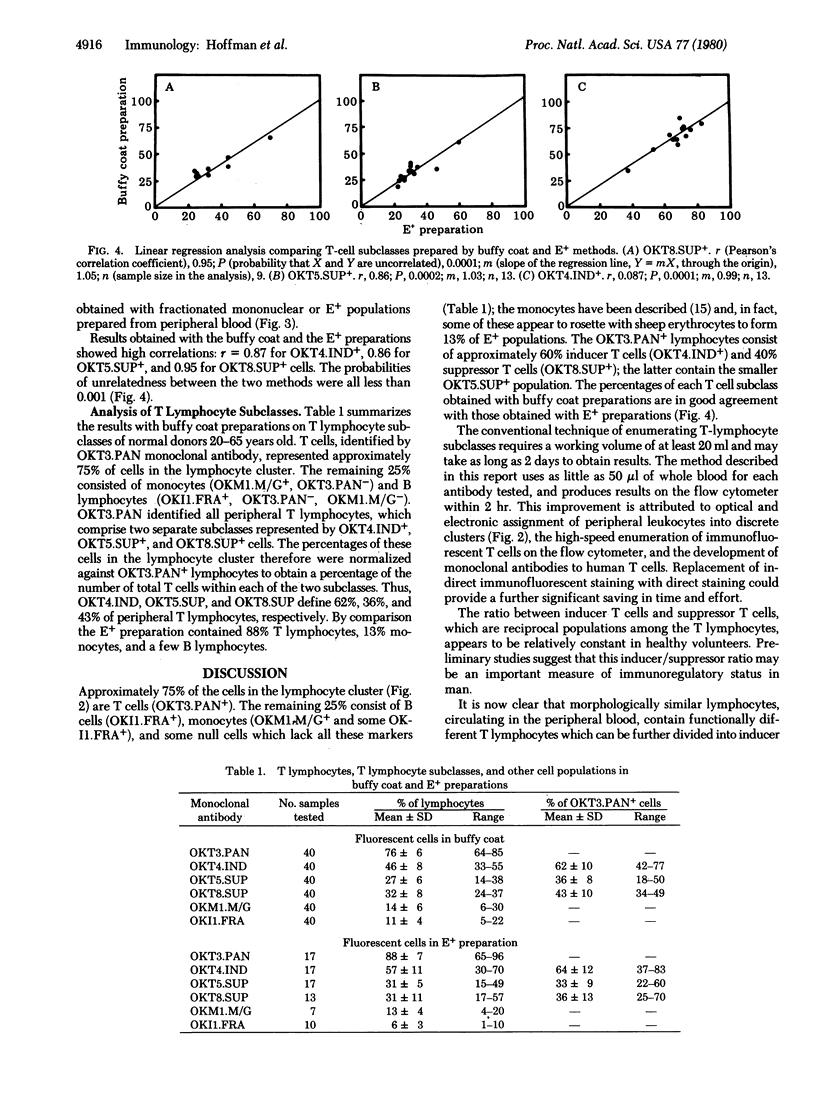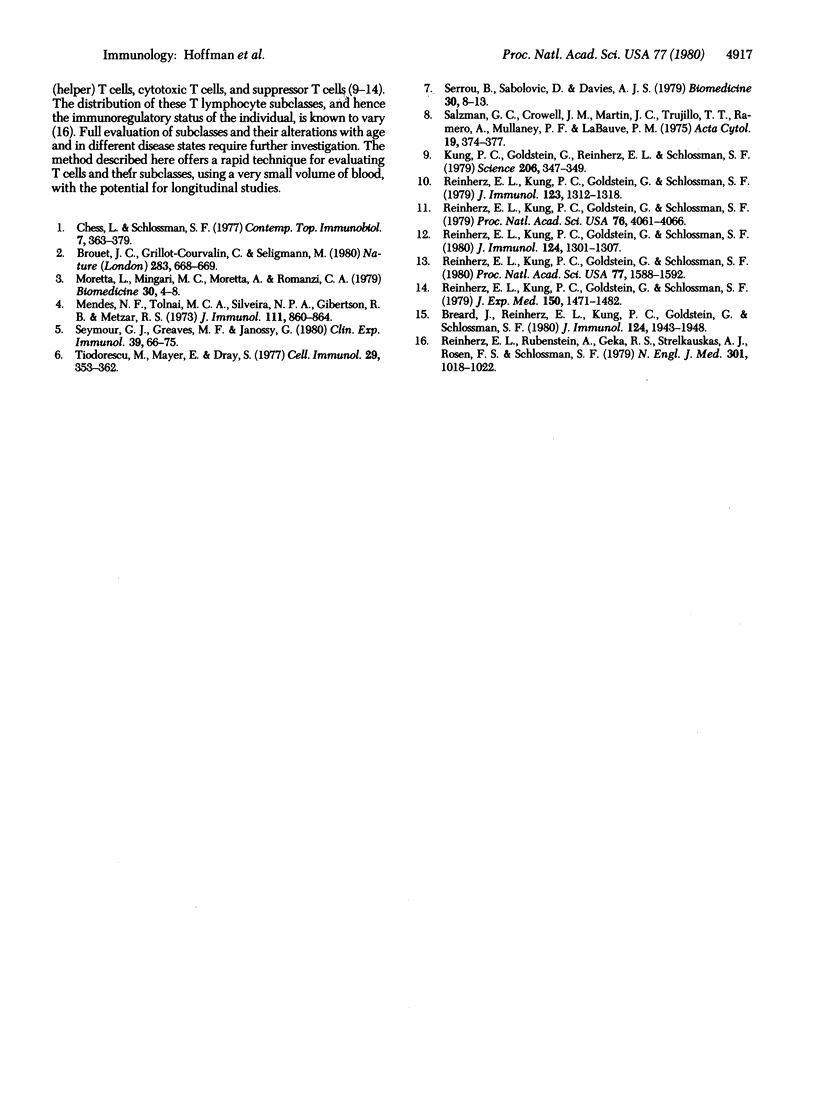Abstract
A simple and rapid method for the determination of human T lymphocyte subclasses in buffy coat preparations or whole blood is described. This technique uses flow cytometry to distinguish lymphocytes from other leukocytes on the basis of their light-scattering properties. Lymnphocyte subclasses were enumerated by cellular immunofluorescence; the immunofluorescent signals were produced by monoclonal antibodies to surface differentiation antigens on T cells. Conventional techniques of enumerating T lymphocyte subclasses entail time-consuming (up to 2 days) density gradient and E rosette enrichement, and require at least 20 ml of blood. The method described here uses as little as 50 microliters of whole blood for each antibody tested and produces results within in 2 hr.
Full text
PDF



Selected References
These references are in PubMed. This may not be the complete list of references from this article.
- Breard J., Reinherz E. L., Kung P. C., Goldstein G., Schlossman S. F. A monoclonal antibody reactive with human peripheral blood monocytes. J Immunol. 1980 Apr;124(4):1943–1948. [PubMed] [Google Scholar]
- Brouet J. C., Grillot-Courvalin C., Seligmann M. Human antibody reacts with a B-cell subset in man to induce B-cell differentiation. Nature. 1980 Feb 14;283(5748):668–669. doi: 10.1038/283668a0. [DOI] [PubMed] [Google Scholar]
- Chess L., Schlossman S. F. Functional analysis of distinct human T-cell subsets bearing unique differentiation antigens. Contemp Top Immunobiol. 1977;7:363–379. doi: 10.1007/978-1-4684-3054-7_10. [DOI] [PubMed] [Google Scholar]
- Kung P., Goldstein G., Reinherz E. L., Schlossman S. F. Monoclonal antibodies defining distinctive human T cell surface antigens. Science. 1979 Oct 19;206(4416):347–349. doi: 10.1126/science.314668. [DOI] [PubMed] [Google Scholar]
- Mendes N. F., Tolnai M. E., Silveira N. P., Gilbertsen R. B., Metzgar R. S. Technical aspects of the rosette tests used to detect human complement receptor (B) and sheep erythrocyte-binding (T) lymphocytes. J Immunol. 1973 Sep;111(3):860–867. [PubMed] [Google Scholar]
- Reinherz E. L., Kung P. C., Goldstein G., Levey R. H., Schlossman S. F. Discrete stages of human intrathymic differentiation: analysis of normal thymocytes and leukemic lymphoblasts of T-cell lineage. Proc Natl Acad Sci U S A. 1980 Mar;77(3):1588–1592. doi: 10.1073/pnas.77.3.1588. [DOI] [PMC free article] [PubMed] [Google Scholar]
- Reinherz E. L., Kung P. C., Goldstein G., Schlossman S. F. A monoclonal antibody reactive with the human cytotoxic/suppressor T cell subset previously defined by a heteroantiserum termed TH2. J Immunol. 1980 Mar;124(3):1301–1307. [PubMed] [Google Scholar]
- Reinherz E. L., Kung P. C., Goldstein G., Schlossman S. F. A monoclonal antibody with selective reactivity with functionally mature human thymocytes and all peripheral human T cells. J Immunol. 1979 Sep;123(3):1312–1317. [PubMed] [Google Scholar]
- Reinherz E. L., Kung P. C., Goldstein G., Schlossman S. F. Separation of functional subsets of human T cells by a monoclonal antibody. Proc Natl Acad Sci U S A. 1979 Aug;76(8):4061–4065. doi: 10.1073/pnas.76.8.4061. [DOI] [PMC free article] [PubMed] [Google Scholar]
- Reinherz E. L., Kung P. C., Pesando J. M., Ritz J., Goldstein G., Schlossman S. F. Ia determinants on human T-cell subsets defined by monoclonal antibody. Activation stimuli required for expression. J Exp Med. 1979 Dec 1;150(6):1472–1482. doi: 10.1084/jem.150.6.1472. [DOI] [PMC free article] [PubMed] [Google Scholar]
- Reinherz E. L., Rubinstein A., Geha R. S., Strelkauskas A. J., Rosen F. S., Schlossman S. F. Abnormalities of immunoregulatory T cells in disorders of immune function. N Engl J Med. 1979 Nov 8;301(19):1018–1022. doi: 10.1056/NEJM197911083011902. [DOI] [PubMed] [Google Scholar]
- Salzman G. C., Crowell J. M., Martin J. C., Trujillo T. T., Romero A., Mullaney P. F., LaBauve P. M. Cell classification by laser light scattering: identification and separation of unstained leukocytes. Acta Cytol. 1975 Jul-Aug;19(4):374–377. [PubMed] [Google Scholar]
- Serrou B., Sabolovic D., Davies A. J. Techniques of separation and characterization of human lymphocytes. Biomedicine. 1979 Feb;30(1):8–13. [PubMed] [Google Scholar]
- Seymour G. J., Greaves M. F., Janossy G. Identification of cells expressing T and p28,33 (Ia-like) antigens in sections of human lymphoid tissue. Clin Exp Immunol. 1980 Jan;39(1):66–75. [PMC free article] [PubMed] [Google Scholar]
- Teodorescu M., Mayer E. P., Dray S. Identification of five human lymphocyte subpopulations by their differential binding of various strains of bacteria. Cell Immunol. 1977 Mar 15;29(2):353–362. doi: 10.1016/0008-8749(77)90330-6. [DOI] [PubMed] [Google Scholar]


